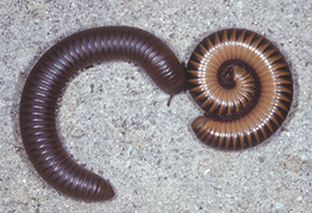Preventing Millipedes from Becoming a Nuisance During the Fall
Nashville, Ark. – The presence of centipedes or “hundred-legged worms” around the house usually indicates that insects are also present and are being used as food by the centipedes. All species bear a pair of front legs equipped with claws having poison glands at the base. These legs extend forward to work with the mouthparts and are used to subdue and kill insects and other small prey. Large tropical species of centipedes are said to be quite venomous and capable of inflicting serious injury to humans. The small species found generally distributed over Arkansas are harmless. A single large dark brown centipede (Scolopendra) appears to be large enough to puncture human skin with poison claws. However, no instances of human injury by this large centipede have been reported in Arkansas.
A close relatives of the centipedes are the “thousand-legged worms” or millipedes. The kinds that occur in Arkansas are entirely harmless. Some millipede species have repugnatorial glands, but none of the secretions from these glands are known to be harmful to humans. Millipedes neither bite nor sting. Millipedes vary from less than 1/2 inch up to 3 inches in length. When disturbed, they typically curl up into a tight ring and remain motionless. Their food is decaying organic matter and thus, they are usually found in flower beds that contain leaf mold and other organic mulches. Occasionally, millipedes migrate in large numbers from flower beds along foundations up into porches or houses. They can be controlled by spraying the foundation walls and window sills with insecticides.
If millipedes or centipedes are occurring in great numbers indoors, it is usually an indication that there is a large population in the area surrounding the home. To control these pests, the most important step is to remove materials that provide them with shelter in the immediate area around the home. This includes mulch, rocks, boards and similar materials. Secondly, dethatching the lawn and mowing closely allows for drier conditions, which repels these pests. Watering in the morning rather than the evening also gives the lawn a chance to dry before the millipedes become active at night. Thirdly, prevent them from entering the house by making sure doors and windows fit tightly and cracks and crevices are caulked. If necessary, insecticides are available that are labeled for outdoor use against millipedes and centipedes. These include products containing carbaryl (Sevin WP), bifenthrin (Ortho-Klor Termite & Carpenter Ant Killer Concentrate, Ortho Bug-B-Gon Max Lawn & Garden Insect Killer Concentrate or Ortho Home Defense Max Perimeter & Indoor Insect Killer Ready-To-Use), lambda-cyhalothrin (Spectracide Triazicide Once & Done, Spectracide Bug Stop Indoor Plus Outdoor Insect Killer Ready-To-Use or Spectracide Triazicide Once & Done Insect Killer Ready-To-Use), cyfluthrin (Bayer Advanced Power Force Carpenter Ant & Termite Killer Plus Concentrate or Bayer Advance Home Pest Control Indoor & Outdoor Insect Killer Ready-To-Use), esfenvalerate (Ortho Bug-B-Gon Multi-Purpose Insect Killer Ready-To-Use) or deltamethrin (Bayer Advance Power Force Carpenter Ant & Termite Killer Plus Ready-To-Use). Apply insecticides around the outside of the home, concentrating where millipedes and centipedes may live or enter the structure. Treat the lower 2 to 3 feet of the foundation wall as well as a band of soil 2 to 4 feet out from the foundation. Applications should be made with just enough water for the insecticide to penetrate through mulch and thatch to reach the soil. Although pesticides are available for indoor use, removal with a vacuum or dustpan and broom is often sufficient.
Pesticides provide only temporary control unless measures are taken to alter the environment outside the home as described above.
For more information, download the Biology and Control of Spiders, Scorpions, Centipedes, and Millipedes publication, or send an email to shorn@uada.edu. Howard County Extension office is still working and is there for all the residents in Howard County during this time.
By Samantha Horn
County Extension Agent - Agriculture
The Cooperative Extension Service
U of A System Division of Agriculture
Media Contact: Samantha Kroll
County Extension Agent - Agriculture
U of A Division of Agriculture
Cooperative Extension Service
421 N. Main Nashville AR 71852
(870) 845-7517
skroll@uada.edu
Related Links
The Arkansas Cooperative Extension Service is an equal opportunity institution. If
you require a reasonable accommodation to participate or need materials in another
format, please contact your County Extension office (or other appropriate office)
as soon as possible. Dial 711 for Arkansas Relay.
Pursuant to 7 CFR § 15.3, the University of Arkansas System Division of Agriculture
offers all its Extension and Research programs and services (including employment)
without regard to race, color, sex, national origin, religion, age, disability, marital
or veteran status, genetic information, sexual preference, pregnancy or any other
legally protected status, and is an equal opportunity institution.
